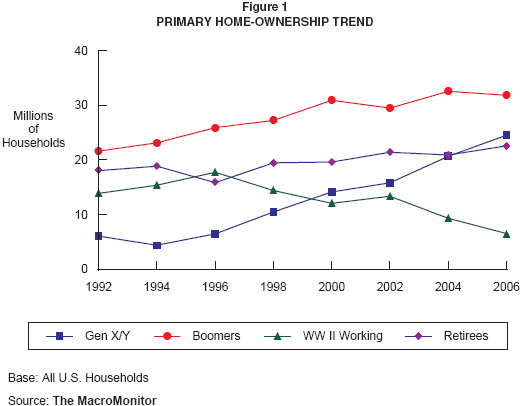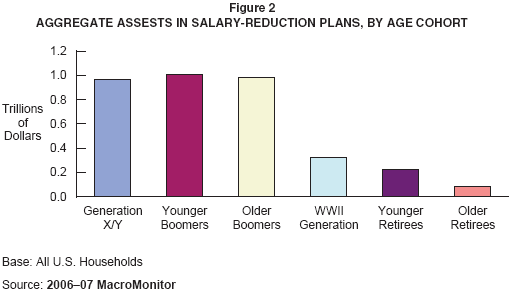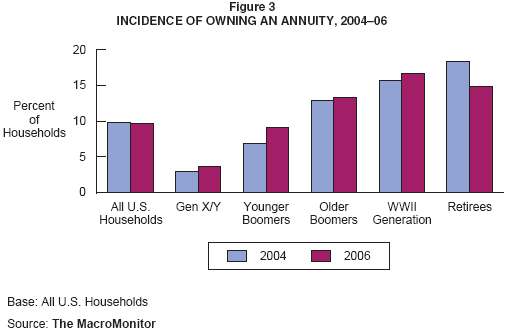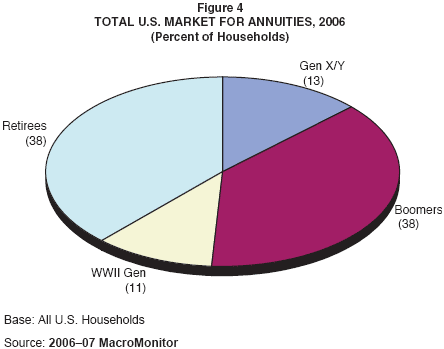MacroMonitor Market Trends May 2007
MacroMonitor Market Trends highlights topical news and trends of interest to you and your colleagues. If you would like more information about the items in the newsletter or would like to discuss other ways that we can assist you in your research and marketing efforts, please contact us.
In this issue:
Boomers and Real Estate
The real estate market continues in the doldrums, and the Boomers are the most likely to feel the effects of this situation.

Although growth in the number of Boomer households that own their own home has reached a plateau, those households remain the largest block of homeowners among the Age Cohorts. Growth continues among Gen X/Yers as they increasingly start their own households and enter the market. The growth in the number of Retirees that own their own homes comes from the household heads' living longer and the increase in the number of households that are retired. In addition to being the most numerous homeowners, Boomers are also much more likely than other Age Cohorts to own other forms of real estate such as vacation homes and rental property. Boomers are the cohort most likely to own any form of real estate. Unlike the Retirees who have either already sold their real estate and taken the equity out of it or decided that they will not, Boomers may be more likely to sell it in the near term in an attempt to extricate the equity as they transition into retirement. Declining or depressed property values that remain low for a long time could affect the Boomers more than the other cohorts.
IRA Rollover Market Yet to "Boom"

Financial marketers and advisors alike have long been awaiting a massive surge in the amount of dollars that savers roll over from 401(k)s and other employee-sponsored retirement plans into IRAs. The impending retirement of the mass of Boomers—whose household number is close to 41 million, of which the oldest members turned 60 in 2006—has had the financial-services industry chomping at the bit. The MacroMonitor data show that, thus far, few signs indicate that the Boomers have begun to retire and roll over their assets. In 2006, savers rolled over just shy of an aggregate $200 billion in workplace assets into IRAs or SEPs—down from $295 billion in 2004 and $422 billion in 2002. This downtick indicates that few Boomers are taking on early retirement—possibly choosing to work until traditional retirement age or beyond—or that Boomers who are retiring are choosing not to roll over their workplace assets—or a combination of both. Obviously, time remains for financial marketers who haven't made a connection with the Boomers to make one going forward and to understand the Boomers' investment horizons, given that this cohort currently holds nearly $2 trillion in 401(k)s, 403(b)s, and 457s.
Younger Boomers and Growth in Annuities
Annuities as an integral part of one's retirement portfolio have not yet gained traction among U.S. households. The MacroMonitor data show no growth in the overall market penetration of annuities, with just one in ten U.S. households owning an annuity both in 2004 and in 2006. Although older Age Cohorts (WWII Generation and Retirees) show the highest incidences for owning an annuity (17% and 15%, respectively, in 2006), the only real growth in ownership comes from younger households. The incidence among Younger Boomers, in particular, rose by 32% during the 2004–06 period, albeit from a paltry 7% of these households to 9%.

Boomers concerned about diversifying their future sources of retirement income are prime potential annuity customers. Already, working Boomers and Retirees account for equally large shares of the total annuity market: 38% each. To broaden the appeal of annuities for Boomers, financial institutions might consider offering annuity products with more flexible purchase and benefit options or other features, such as greater accessibility to funds, that would likely appeal to Boomers with more limited resources.
